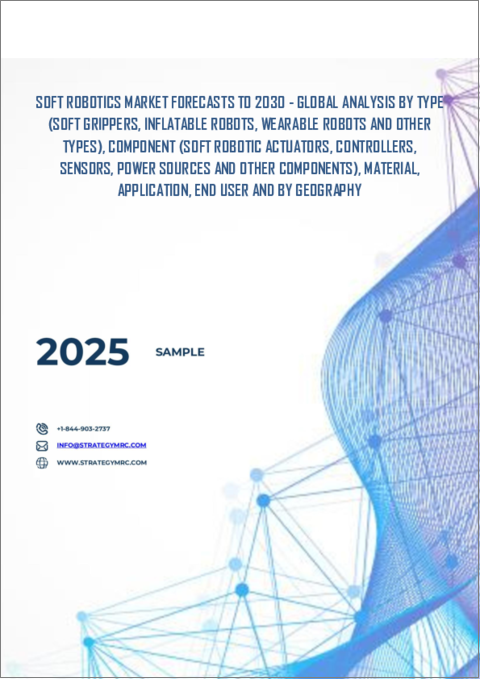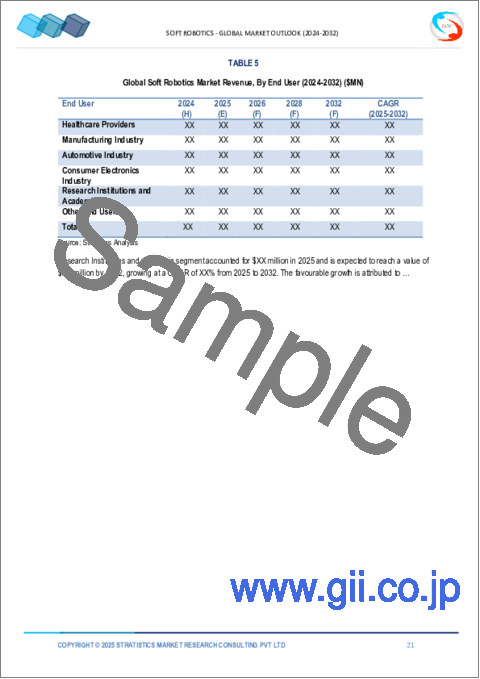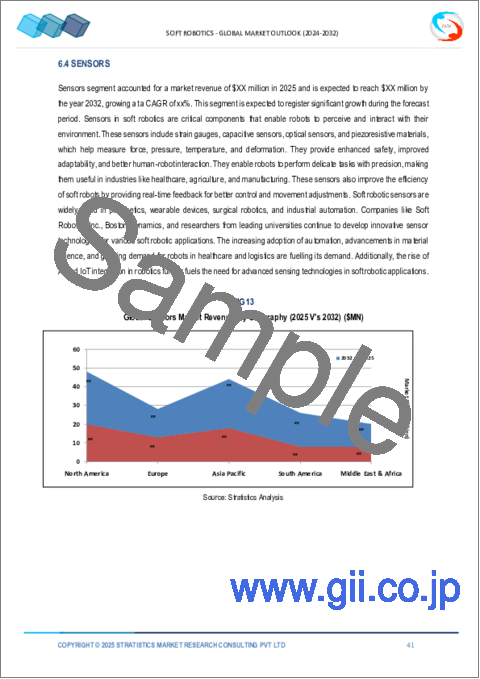|
|
市場調査レポート
商品コード
1503403
ソフトロボティクス市場の2030年までの予測: タイプ別、コンポーネント別、材料別、用途別、エンドユーザー別、地域別の世界分析Soft Robotics Market Forecasts to 2030 - Global Analysis By Type, Component, Material, Application, End User and By Geography |
||||||
カスタマイズ可能
|
|||||||
| ソフトロボティクス市場の2030年までの予測: タイプ別、コンポーネント別、材料別、用途別、エンドユーザー別、地域別の世界分析 |
|
出版日: 2024年06月06日
発行: Stratistics Market Research Consulting
ページ情報: 英文 200+ Pages
納期: 2~3営業日
|
全表示
- 概要
- 図表
- 目次
Stratistics MRCによると、世界のソフトロボティクス市場は2024年に11億米ドルを占め、予測期間中のCAGRは42.4%で成長し、2030年には96億米ドルに達する見込みです。
ソフト・ロボティクスは、柔軟性があり、多くの場合、生体から着想を得た素材を使用してロボットを設計・製作するもので、適応性があり、人間や繊細な物体との安全なインタラクションを可能にします。この分野は、材料科学の進歩や、ヘルスケア、製造業、コンシューマー・エレクトロニクスにおける応用の増加により急速に成長しています。リハビリテーション機器から自動食品ハンドリングシステムまで、多様な用途でより安全で効率的な技術に対する需要の高まりに後押しされ、産業界がより多用途で効率的な自動化ソリューションを求めるにつれて、市場は拡大しています。
IEEEが2022年5月に実施したソフトロボティクス支援低侵襲手術(RAMIS)と介入に関する調査によると、狭い切開創で行う腹腔鏡手術の出現により、外科界では従来の開腹手術からの迅速なシフトが促されました。
自動化需要の増加
自動化に対する需要の高まりは、産業界が手術の効率性、精度、安全性を高めようとする中で、ソフトロボティクス市場を牽引しています。ソフトロボティクスは柔軟性と適応性を備えており、ヘルスケア、食品加工、家電製品など、従来の硬質ロボットが適さない分野での自動化を可能にします。デリケートな物体を扱い、人間と安全に相互作用できるソフトロボティクスは、こうした用途に最適であるため、その採用と市場成長が加速しています。
高い開発コスト
開発コストの高さは、ソフトロボティクス市場の大きな抑制要因となっています。ソフトロボティクスシステムの研究、設計、生産には、高度な材料、技術、熟練労働力への多額の投資が必要です。こうした初期コストの高さは、中小企業や新興企業にとっては障壁となり、市場への参入を制限する要因となります。さらに、信頼性と耐久性に優れたソフトロボティクスの開発は複雑であるため、コストがさらに上昇し、普及が遅れる可能性があります。
AIや機械学習との統合
AIは、より賢く自律的で適応力のあるシステムを可能にすることで、ソフトロボティクスの能力を向上させる。この相乗効果により、ロボットがリハビリを支援するヘルスケアや、プロセスを最適化しダウンタイムを削減する製造業などの分野で新たな用途が開拓され、イノベーションと市場拡大が促進されます。
従来のロボットとの競合
確立された硬質ロボットシステムは、産業界で広く使用されており、信頼性と効率性が実証されています。こうした従来のロボットは、ソフトロボティクスに比べて開発・導入コストが低い場合が多いです。その結果、潜在的な顧客は、特に柔軟性や穏やかなハンドリングがそれほど重要でないアプリケーションでは、従来のソリューションに固執することを好む可能性があり、ソフトロボティクス市場の成長を制限する可能性があります。
COVID-19の影響:
COVID-19の流行は、自動化と非接触操作の必要性から、ヘルスケアと製造業におけるソフトロボティクスの採用を加速させました。ソフトロボティクスは、消毒、患者ケア、自動化された製造プロセスなどの作業で活用され、社会的距離を維持し、人間の介入を減らすことで、その重要性が強調され、パンデミック時の市場成長を促進しています。
ソフトグリッパー分野は予測期間中最大になる見込み
ソフトグリッパー分野は、飲食品、物流、製造業など様々な産業で広く応用されているため、最大規模になると予想されます。これらのグリッパーは、デリケートで不規則な形状の物体を安全に扱うことができるため、精密さと慎重さが求められる自動化プロセスでは不可欠です。汎用性が高く、製品に損傷を与えることなくさまざまな作業に適応できることから、その価値は高く、ソフトロボティクス分野で大きな市場シェアを牽引しています。
予測期間中、形状記憶合金分野が最も高いCAGRが見込まれる
形状記憶合金分野は、加熱するとあらかじめ定義された形状に戻る能力など、これらの材料のユニークな特性により、最も高いCAGRを示すと予想されます。この特性により、形状記憶合金はソフトロボティクス内のアクチュエーターや適応構造での使用に最適となり、高度な機能性と性能の向上が可能になります。革新的な用途、特に医療機器や適応システムへの関心の高まりが、このセグメントの急成長に拍車をかけています。
最大のシェアを占める地域
北米は、強力な技術インフラ、研究開発への多額の投資、主要な業界プレイヤーの存在により、ソフトロボティクス市場を独占する立場にあります。同地域の先進ヘルスケア分野、新技術の高い採用率、確立された製造業がさらに市場シェア上位に貢献しています。さらに、さまざまな用途における自動化と技術革新への需要が、北米の市場規模を大きく押し上げています。
CAGRが最も高い地域:
アジア太平洋地域は、急速な工業化、自動化技術への投資の増加、業界全体における業務効率向上の重視の高まりにより、ソフトロボティクス市場の急成長が見込まれています。中国、日本、韓国のような国々は、政府の強力な支援と技術の大幅な進歩に後押しされ、先進的なロボットソリューション導入の最前線にいます。この力強い成長の可能性により、アジア太平洋地域は市場で最も急成長している地域となっています。
無料カスタマイズサービス:
本レポートをご購読のお客様には、以下の無料カスタマイズオプションのいずれかをご利用いただけます:
- 企業プロファイル
- 追加市場プレイヤーの包括的プロファイリング(3社まで)
- 主要企業のSWOT分析(3社まで)
- 地域セグメンテーション
- 顧客の関心に応じた主要国の市場推計・予測・CAGR(注:フィージビリティチェックによる)
- 競合ベンチマーキング
- 製品ポートフォリオ、地理的プレゼンス、戦略的提携に基づく主要企業のベンチマーキング
目次
第1章 エグゼクティブサマリー
第2章 序文
- 概要
- ステークホルダー
- 調査範囲
- 調査手法
- データマイニング
- データ分析
- データ検証
- 調査アプローチ
- 調査情報源
- 1次調査情報源
- 2次調査情報源
- 前提条件
第3章 市場動向分析
- 促進要因
- 抑制要因
- 機会
- 脅威
- 用途分析
- エンドユーザー分析
- 新興市場
- COVID-19の影響
第4章 ポーターのファイブフォース分析
- 供給企業の交渉力
- 買い手の交渉力
- 代替品の脅威
- 新規参入業者の脅威
- 競争企業間の敵対関係
第5章 世界のソフトロボティクス市場:タイプ別
- ソフトグリッパー
- 空気圧グリッパー
- 油圧グリッパー
- 電動グリッパー
- インフレータブルロボット
- ウェアラブルロボット
- 外骨格
- 可食ロボット
- その他のタイプ
第6章 世界のソフトロボティクス市場:コンポーネント別
- ソフトロボティクスアクチュエータ
- コントローラー
- センサー
- 電源
- その他のコンポーネント
第7章 世界のソフトロボティクス市場:材料別
- エラストマー
- ジェル
- 形状記憶合金
- 導電性ポリマー
- その他の材料
第8章 世界のソフトロボティクス市場:用途別
- 医療用途
- 外科用ロボット
- リハビリテーションロボット
- 診断および支援技術
- 飲食品
- 加工
- 包装
- ロジスティクス
- エンターテイメントとゲーム
- 調査と探査
- ヒューマンマシンインターフェースとインタラクション
- 移動と検査
- 操作
- その他の用途
第9章 世界のソフトロボティクス市場:エンドユーザー別
- ヘルスケア提供者
- 製造業
- 自動車産業
- 家電業界
- 研究機関および学術機関
- その他のエンドユーザー
第10章 世界のソフトロボティクス市場:地域別
- 北米
- 米国
- カナダ
- メキシコ
- 欧州
- ドイツ
- 英国
- イタリア
- フランス
- スペイン
- その他欧州
- アジア太平洋地域
- 日本
- 中国
- インド
- オーストラリア
- ニュージーランド
- 韓国
- その他アジア太平洋地域
- 南米
- アルゼンチン
- ブラジル
- チリ
- その他南米
- 中東・アフリカ
- サウジアラビア
- アラブ首長国連邦
- カタール
- 南アフリカ
- その他中東とアフリカ
第11章 主な発展
- 契約、パートナーシップ、コラボレーション、合弁事業
- 買収と合併
- 新製品発売
- 事業拡大
- その他の主要戦略
第12章 企業プロファイリング
- Soft Robotics Inc.
- Festo AG & Co. KG
- ABB Ltd
- FANUC Corporation
- KUKA AG
- Yaskawa Electric Corporation
- Universal Robots A/S
- Rethink Robotics
- RightHand Robotics, Inc.
- Ekso Bionics Holdings, Inc.
- ReWalk Robotics Ltd.
- Cyberdyne Inc.
- Myomo, Inc.
- Bioservo Technologies AB
- SynTouch Inc.
- Empire Robotics, Inc.
- Grabit Inc.
- OptoForce Ltd.
- Shadow Robot Company
- SoftWear Automation, Inc.
List of Tables
- Table 1 Global Soft Robotics Market Outlook, By Region (2022-2030) ($MN)
- Table 2 Global Soft Robotics Market Outlook, By Type (2022-2030) ($MN)
- Table 3 Global Soft Robotics Market Outlook, By Soft Grippers (2022-2030) ($MN)
- Table 4 Global Soft Robotics Market Outlook, By Pneumatic Grippers (2022-2030) ($MN)
- Table 5 Global Soft Robotics Market Outlook, By Hydraulic Grippers (2022-2030) ($MN)
- Table 6 Global Soft Robotics Market Outlook, By Electric Grippers (2022-2030) ($MN)
- Table 7 Global Soft Robotics Market Outlook, By Inflatable Robots (2022-2030) ($MN)
- Table 8 Global Soft Robotics Market Outlook, By Wearable Robots (2022-2030) ($MN)
- Table 9 Global Soft Robotics Market Outlook, By Exoskeletons (2022-2030) ($MN)
- Table 10 Global Soft Robotics Market Outlook, By Edible Robots (2022-2030) ($MN)
- Table 11 Global Soft Robotics Market Outlook, By Other Types (2022-2030) ($MN)
- Table 12 Global Soft Robotics Market Outlook, By Component (2022-2030) ($MN)
- Table 13 Global Soft Robotics Market Outlook, By Soft Robotic Actuators (2022-2030) ($MN)
- Table 14 Global Soft Robotics Market Outlook, By Controllers (2022-2030) ($MN)
- Table 15 Global Soft Robotics Market Outlook, By Sensors (2022-2030) ($MN)
- Table 16 Global Soft Robotics Market Outlook, By Power Sources (2022-2030) ($MN)
- Table 17 Global Soft Robotics Market Outlook, By Other Components (2022-2030) ($MN)
- Table 18 Global Soft Robotics Market Outlook, By Material (2022-2030) ($MN)
- Table 19 Global Soft Robotics Market Outlook, By Elastomers (2022-2030) ($MN)
- Table 20 Global Soft Robotics Market Outlook, By Gels (2022-2030) ($MN)
- Table 21 Global Soft Robotics Market Outlook, By Shape Memory Alloys (2022-2030) ($MN)
- Table 22 Global Soft Robotics Market Outlook, By Conductive Polymers (2022-2030) ($MN)
- Table 23 Global Soft Robotics Market Outlook, By Other Materials (2022-2030) ($MN)
- Table 24 Global Soft Robotics Market Outlook, By Application (2022-2030) ($MN)
- Table 25 Global Soft Robotics Market Outlook, By Medical Applications (2022-2030) ($MN)
- Table 26 Global Soft Robotics Market Outlook, By Surgical Robotics (2022-2030) ($MN)
- Table 27 Global Soft Robotics Market Outlook, By Rehabilitation Robotics (2022-2030) ($MN)
- Table 28 Global Soft Robotics Market Outlook, By Diagnostic and Assistive Technologies (2022-2030) ($MN)
- Table 29 Global Soft Robotics Market Outlook, By Food and Beverages (2022-2030) ($MN)
- Table 30 Global Soft Robotics Market Outlook, By Processing (2022-2030) ($MN)
- Table 31 Global Soft Robotics Market Outlook, By Packaging (2022-2030) ($MN)
- Table 32 Global Soft Robotics Market Outlook, By Logistics (2022-2030) ($MN)
- Table 33 Global Soft Robotics Market Outlook, By Entertainment and Gaming (2022-2030) ($MN)
- Table 34 Global Soft Robotics Market Outlook, By Survey and Exploration (2022-2030) ($MN)
- Table 35 Global Soft Robotics Market Outlook, By Human-Machine Interface and Interaction (2022-2030) ($MN)
- Table 36 Global Soft Robotics Market Outlook, By Mobility and Inspection (2022-2030) ($MN)
- Table 37 Global Soft Robotics Market Outlook, By Manipulation (2022-2030) ($MN)
- Table 38 Global Soft Robotics Market Outlook, By Other Applications (2022-2030) ($MN)
- Table 39 Global Soft Robotics Market Outlook, By End User (2022-2030) ($MN)
- Table 40 Global Soft Robotics Market Outlook, By Healthcare Providers (2022-2030) ($MN)
- Table 41 Global Soft Robotics Market Outlook, By Manufacturing Industry (2022-2030) ($MN)
- Table 42 Global Soft Robotics Market Outlook, By Automotive Industry (2022-2030) ($MN)
- Table 43 Global Soft Robotics Market Outlook, By Consumer Electronics Industry (2022-2030) ($MN)
- Table 44 Global Soft Robotics Market Outlook, By Research Institutions and Academia (2022-2030) ($MN)
- Table 45 Global Soft Robotics Market Outlook, By Other End Users (2022-2030) ($MN)
Note: Tables for North America, Europe, APAC, South America, and Middle East & Africa Regions are also represented in the same manner as above.
According to Stratistics MRC, the Global Soft Robotics Market is accounted for $1.1 billion in 2024 and is expected to reach $9.6 billion by 2030 growing at a CAGR of 42.4% during the forecast period. Soft robotics involves designing and creating robots using flexible, often bio-inspired materials that enable adaptability and safe interaction with humans and delicate objects. This field is rapidly growing due to advancements in material science and increasing applications in healthcare, manufacturing, and consumer electronics. The market is expanding as industries seek more versatile, efficient automation solutions, driven by rising demand for safer, more efficient technologies in diverse applications, from rehabilitation devices to automated food handling systems.
According to a study conducted by IEEE in May 2022 on Soft Robot-Assisted Minimally Invasive Surgery (RAMIS) and interventions, the advent of laparoscopic surgery, performed through narrow incisions, prompted a swift shift in the surgical community away from traditional open surgery.
Market Dynamics:
Driver:
Increasing demand for automation
The increasing demand for automation is driving the soft robotics market as industries seek to enhance efficiency, precision, and safety in operations. Soft robotics offers flexibility and adaptability, allowing for automation in sectors where traditional rigid robots are unsuitable, such as healthcare, food processing, and consumer electronics. The ability to handle delicate objects and interact safely with humans makes soft robots ideal for these applications, thus accelerating their adoption and market growth.
Restraint:
High development costs
High development costs are a significant restraint for the soft robotics market. The research, design, and production of soft robotic systems require substantial investment in advanced materials, technology, and skilled labor. These high upfront costs can be a barrier for smaller companies and startups, limiting their ability to enter the market. Additionally, the complexity of developing reliable and durable soft robots can further escalate costs, slowing down widespread adoption.
Opportunity:
Integration with AI and machine learning
AI enhances the capabilities of soft robots by enabling smarter, more autonomous, and adaptive systems that can learn from their environment and improve performance over time. This synergy opens up new applications in areas such as healthcare, where robots can assist in rehabilitation, and in manufacturing, where they can optimize processes and reduce downtime, driving innovation and market expansion.
Threat:
Competition from traditional robotics
Established rigid robotic systems are widely used across industries and have proven reliability and efficiency. These traditional robots often have a lower cost of development and deployment compared to soft robotics. As a result, potential customers may prefer sticking to conventional solutions, particularly in applications where flexibility and gentle handling are less critical, potentially limiting the growth of the soft robotics market.
Covid-19 Impact:
The COVID-19 pandemic has accelerated the adoption of soft robotics in healthcare and manufacturing due to the need for automation and contactless operations. Soft robots have been utilized in tasks such as disinfection, patient care, and automated manufacturing processes to maintain social distancing and reduce human intervention, highlighting their importance and driving market growth during the pandemic.
The soft grippers segment is expected to be the largest during the forecast period
The soft grippers segment is expected to be the largest due to their widespread application across various industries such as food and beverage, logistics, and manufacturing. These grippers can safely handle delicate and irregularly shaped objects, which is essential in automated processes that require precision and care. Their versatility and ability to adapt to different tasks without causing damage to products make them highly valuable, driving significant market share in the soft robotics sector.
The shape memory alloys segment is expected to have the highest CAGR during the forecast period
The shape memory alloys segment is expected to exhibit the highest CAGR due to the unique properties of these materials, such as their ability to return to a predefined shape upon heating. This characteristic makes shape memory alloys ideal for use in actuators and adaptive structures within soft robots, enabling advanced functionalities and improved performance. The growing interest in innovative applications, especially in medical devices and adaptive systems, is fueling rapid growth in this segment.
Region with largest share:
North America is positioned to dominate the soft robotics market due to its strong technological infrastructure, significant investments in research and development, and the presence of key industry players. The region's advanced healthcare sector, high adoption rate of new technologies, and well-established manufacturing industries further contribute to its leading market share. Furthermore, demand for automation and innovation in various applications drives the substantial market size in North America.
Region with highest CAGR:
The Asia Pacific region anticipates rapid growth in the soft robotics market driven by rapid industrialization, increasing investments in automation technologies, and a growing emphasis on improving operational efficiency across industries. Countries like China, Japan, and South Korea are at the forefront of adopting advanced robotic solutions, fueled by strong government support and significant advancements in technology. This robust growth potential makes Asia Pacific the fastest-growing region in the market.
Key players in the market
Some of the key players in Soft Robotics Market include Soft Robotics Inc., Festo AG & Co. KG, ABB Ltd, FANUC Corporation, KUKA AG, Yaskawa Electric Corporation, Universal Robots A/S, Rethink Robotics, RightHand Robotics, Inc., Ekso Bionics Holdings, Inc., ReWalk Robotics Ltd., Cyberdyne Inc., Myomo, Inc., Bioservo Technologies AB, SynTouch Inc., Empire Robotics, Inc., Grabit Inc., OptoForce Ltd., Shadow Robot Company and SoftWear Automation, Inc.
Key Developments:
In April 2024, Wind River(R), a global leader in delivering software for mission-critical intelligent systems, today announced that Wind River Linux is being used by Yaskawa Electric Corporation, a leading manufacturer of servo motor, AC drives, and industrial robots, in the development of its new product, MOTOMAN NEXT.
In February 2024, Tompkins Solutions, a leading supply chain consulting and material handling integration firm, today announced a strategic partnership with Soft Robotics, a leading provider of innovative robotic automation solutions. This collaboration will deliver cutting-edge AI-powered robotics to logistics operations worldwide, enabling them to address ongoing supply chain issues and optimize order fulfillment.
In July 2023, Festo India announced collaboration with ArcelorMittal Nippon Steel India. The partnership will focus on development of New Age Makers Institute of Technology (NAMTECH), an ArcelorMittal Nippon Steel India education initiative aimed at delivering an integrated model of high-quality engineering and technical education, with special emphasis on manufacturing and sustainability.
Types Covered:
- Soft Grippers
- Inflatable Robots
- Wearable Robots
- Exoskeletons
- Edible Robots
- Other Types
Components Covered:
- Soft Robotic Actuators
- Controllers
- Sensors
- Power Sources
- Other Components
Materials Covered:
- Elastomers
- Gels
- Shape Memory Alloys
- Conductive Polymers
- Other Materials
Applications Covered:
- Medical Applications
- Food and Beverages
- Logistics
- Entertainment and Gaming
- Survey and Exploration
- Human-Machine Interface and Interaction
- Mobility and Inspection
- Manipulation
- Other Applications
End Users Covered:
- Healthcare Providers
- Manufacturing Industry
- Automotive Industry
- Consumer Electronics Industry
- Research Institutions and Academia
- Other End Users
Regions Covered:
- North America
- US
- Canada
- Mexico
- Europe
- Germany
- UK
- Italy
- France
- Spain
- Rest of Europe
- Asia Pacific
- Japan
- China
- India
- Australia
- New Zealand
- South Korea
- Rest of Asia Pacific
- South America
- Argentina
- Brazil
- Chile
- Rest of South America
- Middle East & Africa
- Saudi Arabia
- UAE
- Qatar
- South Africa
- Rest of Middle East & Africa
What our report offers:
- Market share assessments for the regional and country-level segments
- Strategic recommendations for the new entrants
- Covers Market data for the years 2022, 2023, 2024, 2026, and 2030
- Market Trends (Drivers, Constraints, Opportunities, Threats, Challenges, Investment Opportunities, and recommendations)
- Strategic recommendations in key business segments based on the market estimations
- Competitive landscaping mapping the key common trends
- Company profiling with detailed strategies, financials, and recent developments
- Supply chain trends mapping the latest technological advancements
Free Customization Offerings:
All the customers of this report will be entitled to receive one of the following free customization options:
- Company Profiling
- Comprehensive profiling of additional market players (up to 3)
- SWOT Analysis of key players (up to 3)
- Regional Segmentation
- Market estimations, Forecasts and CAGR of any prominent country as per the client's interest (Note: Depends on feasibility check)
- Competitive Benchmarking
- Benchmarking of key players based on product portfolio, geographical presence, and strategic alliances
Table of Contents
1 Executive Summary
2 Preface
- 2.1 Abstract
- 2.2 Stake Holders
- 2.3 Research Scope
- 2.4 Research Methodology
- 2.4.1 Data Mining
- 2.4.2 Data Analysis
- 2.4.3 Data Validation
- 2.4.4 Research Approach
- 2.5 Research Sources
- 2.5.1 Primary Research Sources
- 2.5.2 Secondary Research Sources
- 2.5.3 Assumptions
3 Market Trend Analysis
- 3.1 Introduction
- 3.2 Drivers
- 3.3 Restraints
- 3.4 Opportunities
- 3.5 Threats
- 3.6 Application Analysis
- 3.7 End User Analysis
- 3.8 Emerging Markets
- 3.9 Impact of Covid-19
4 Porters Five Force Analysis
- 4.1 Bargaining power of suppliers
- 4.2 Bargaining power of buyers
- 4.3 Threat of substitutes
- 4.4 Threat of new entrants
- 4.5 Competitive rivalry
5 Global Soft Robotics Market, By Type
- 5.1 Introduction
- 5.2 Soft Grippers
- 5.2.1 Pneumatic Grippers
- 5.2.2 Hydraulic Grippers
- 5.2.3 Electric Grippers
- 5.3 Inflatable Robots
- 5.4 Wearable Robots
- 5.5 Exoskeletons
- 5.6 Edible Robots
- 5.7 Other Types
6 Global Soft Robotics Market, By Component
- 6.1 Introduction
- 6.2 Soft Robotic Actuators
- 6.3 Controllers
- 6.4 Sensors
- 6.5 Power Sources
- 6.6 Other Components
7 Global Soft Robotics Market, By Material
- 7.1 Introduction
- 7.2 Elastomers
- 7.3 Gels
- 7.4 Shape Memory Alloys
- 7.5 Conductive Polymers
- 7.6 Other Materials
8 Global Soft Robotics Market, By Application
- 8.1 Introduction
- 8.2 Medical Applications
- 8.2.1 Surgical Robotics
- 8.2.2 Rehabilitation Robotics
- 8.2.3 Diagnostic and Assistive Technologies
- 8.3 Food and Beverages
- 8.3.1 Processing
- 8.3.2 Packaging
- 8.4 Logistics
- 8.5 Entertainment and Gaming
- 8.6 Survey and Exploration
- 8.7 Human-Machine Interface and Interaction
- 8.8 Mobility and Inspection
- 8.9 Manipulation
- 8.10 Other Applications
9 Global Soft Robotics Market, By End User
- 9.1 Introduction
- 9.2 Healthcare Providers
- 9.3 Manufacturing Industry
- 9.4 Automotive Industry
- 9.5 Consumer Electronics Industry
- 9.6 Research Institutions and Academia
- 9.7 Other End Users
10 Global Soft Robotics Market, By Geography
- 10.1 Introduction
- 10.2 North America
- 10.2.1 US
- 10.2.2 Canada
- 10.2.3 Mexico
- 10.3 Europe
- 10.3.1 Germany
- 10.3.2 UK
- 10.3.3 Italy
- 10.3.4 France
- 10.3.5 Spain
- 10.3.6 Rest of Europe
- 10.4 Asia Pacific
- 10.4.1 Japan
- 10.4.2 China
- 10.4.3 India
- 10.4.4 Australia
- 10.4.5 New Zealand
- 10.4.6 South Korea
- 10.4.7 Rest of Asia Pacific
- 10.5 South America
- 10.5.1 Argentina
- 10.5.2 Brazil
- 10.5.3 Chile
- 10.5.4 Rest of South America
- 10.6 Middle East & Africa
- 10.6.1 Saudi Arabia
- 10.6.2 UAE
- 10.6.3 Qatar
- 10.6.4 South Africa
- 10.6.5 Rest of Middle East & Africa
11 Key Developments
- 11.1 Agreements, Partnerships, Collaborations and Joint Ventures
- 11.2 Acquisitions & Mergers
- 11.3 New Product Launch
- 11.4 Expansions
- 11.5 Other Key Strategies
12 Company Profiling
- 12.1 Soft Robotics Inc.
- 12.2 Festo AG & Co. KG
- 12.3 ABB Ltd
- 12.4 FANUC Corporation
- 12.5 KUKA AG
- 12.6 Yaskawa Electric Corporation
- 12.7 Universal Robots A/S
- 12.8 Rethink Robotics
- 12.9 RightHand Robotics, Inc.
- 12.10 Ekso Bionics Holdings, Inc.
- 12.11 ReWalk Robotics Ltd.
- 12.12 Cyberdyne Inc.
- 12.13 Myomo, Inc.
- 12.14 Bioservo Technologies AB
- 12.15 SynTouch Inc.
- 12.16 Empire Robotics, Inc.
- 12.17 Grabit Inc.
- 12.18 OptoForce Ltd.
- 12.19 Shadow Robot Company
- 12.20 SoftWear Automation, Inc.






